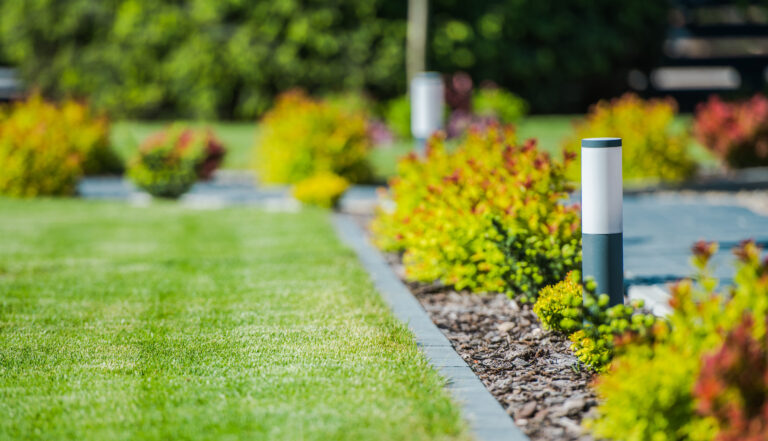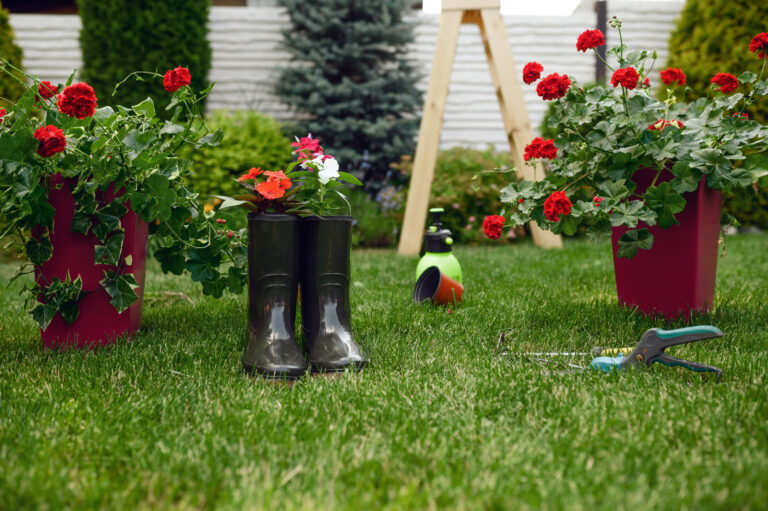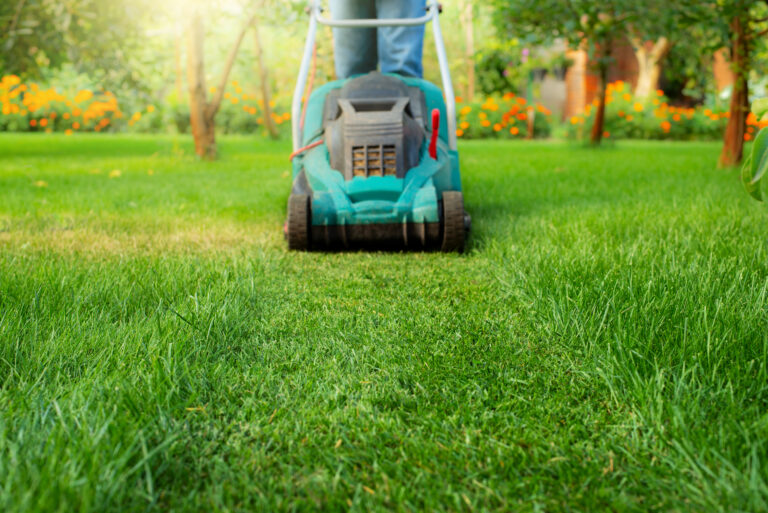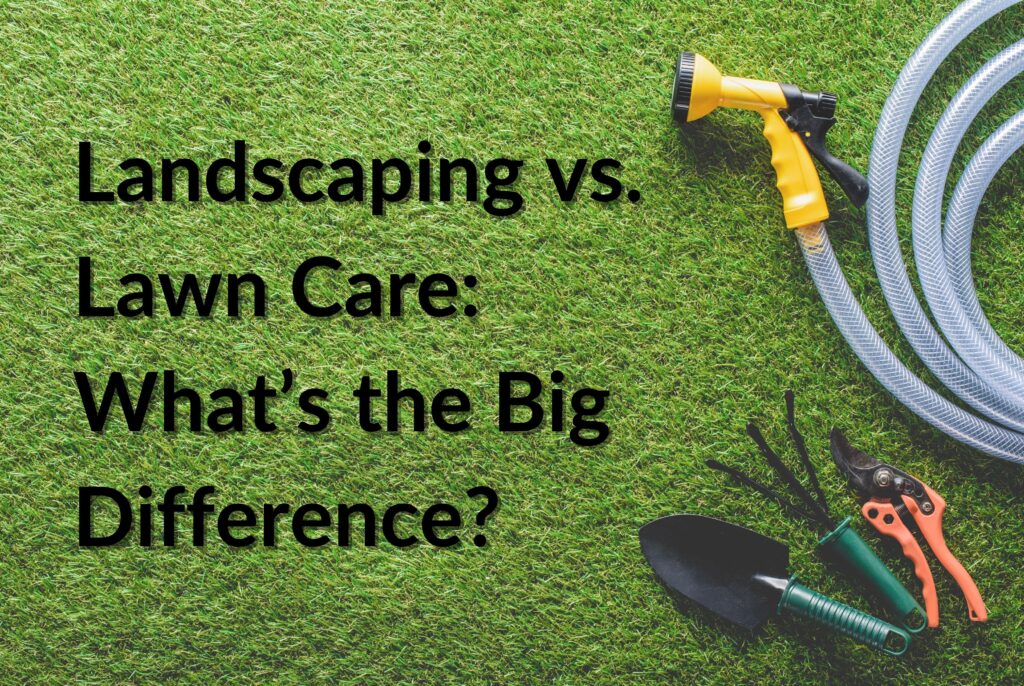Table of Contents
Landscaping
Landscaping involves the comprehensive planning, designing, and implementing of the entire outdoor area. It is an art and science that focuses on creating aesthetically pleasing and functional outdoor spaces that enhance the natural beauty and usability of the area.

Components:
- Design and Planning: This initial phase includes conceptualizing the layout of the garden, selecting plant species, arranging hardscape elements like patios, walkways, water features, and other decorative elements. Landscape architects or designers often use software to create detailed plans and 3D models.
- Installation: This involves planting trees, shrubs, flowers, and installing hardscape features. It can also include adding soil, mulch, and other materials to create the desired look and function. If you’d like to explore options about Mulch Installation, then read our blog 7 Tips for Successful Mulch Installation.
- Structural Elements: Incorporation of elements like retaining walls, pergolas, arbors, and outdoor lighting. These features can create focal points, add structure, and improve the usability of outdoor spaces.
- Seasonal Design: Adjustments for different seasons, such as planting seasonal flowers and ensuring that the landscape remains appealing year-round. This might include adding colorful annuals in spring, maintaining fall foliage, and creating winter interest with evergreens and structural elements.
Goals:
- Creating a visually appealing environment that enhances the property’s overall aesthetic.
- Enhancing the functionality of outdoor spaces by adding areas for relaxation, entertainment, and recreation.
- Adding value to the property through well-thought-out designs and quality installations.
- Reflecting the homeowner’s personal style and preferences, making the outdoor space an extension of their living area.
Benefits:
- Increased Property Value: A well-designed landscape can significantly increase the value of a property.
- Enhanced Curb Appeal: Attractive landscaping can improve the first impression of a property.
- Improved Quality of Life: Functional outdoor spaces can provide areas for relaxation and social activities, enhancing the overall quality of life.
- Environmental Benefits: Thoughtful landscaping can contribute to environmental sustainability by incorporating native plants, reducing water usage, and supporting local wildlife.
Lawn Care
Lawn care focuses on the maintenance and health of the grass and soil in a lawn. It involves routine tasks aimed at keeping the lawn lush, green, and healthy throughout the year.

Components:
- Mowing: Regular cutting of the grass to an appropriate height to promote healthy growth and prevent issues like thatch buildup.
- Fertilizing: Applying nutrients to the lawn to ensure the grass has the necessary elements to thrive. This often involves a schedule of applications throughout the growing season.
- Weed Control: Removing or preventing weeds that can compete with grass for nutrients and space. This can involve both chemical and organic methods.
- Pest Control: Managing pests that can damage the grass or soil, such as grubs, ants, and other insects.
- Aeration: Perforating the soil to allow air, water, and nutrients to penetrate the grass roots. This is typically done in the spring or fall.
- Seeding: Planting new grass seeds to repair damaged areas, improve lawn density, or introduce more resilient grass varieties.
- Watering: Ensuring the lawn receives adequate moisture, especially during dry periods. This can involve setting up irrigation systems or manual watering schedules.
Goals:
- Maintaining a healthy and vibrant lawn that enhances the overall appearance of the landscape.
- Preventing and addressing issues like weeds, pests, and diseases to ensure the grass remains healthy.
- Ensuring the grass remains aesthetically pleasing and functional for activities like play, relaxation, and sports.
Benefits:
- Healthy Lawn: Regular maintenance promotes a dense, green, and resilient lawn.
- Pest and Weed Control: Effective lawn care reduces the prevalence of pests and weeds, minimizing damage to the lawn.
- Improved Soil Health: Practices like aeration and proper fertilization improve soil structure and nutrient availability.
- Enhanced Aesthetic Appeal: A well-maintained lawn contributes significantly to the overall beauty of the landscape.
Key Differences
1) Scope of Work:
- Landscaping:
- Broad Scope: Landscaping encompasses the overall design and creation of outdoor spaces. This includes everything from the initial planning and design to the installation of plants, trees, shrubs, and hardscape elements like patios, walkways, and water features.
- Comprehensive Approach: Landscaping involves both softscape (plants, flowers, grass) and hardscape (stone, concrete, wood structures) elements. It aims to create a cohesive and aesthetically pleasing environment that enhances the property’s overall appeal.
- Lawn Care:
- Narrow Scope: Lawn care focuses specifically on the maintenance and health of the lawn. This includes tasks such as mowing, fertilizing, aeration, weed control, and pest management.
- Routine Maintenance: Lawn care involves regular, ongoing tasks aimed at keeping the grass healthy, lush, and green throughout the year.

2) Objectives:
- Landscaping:
- Aesthetic Enhancement: The primary goal of landscaping is to improve the visual appeal of the property by creating attractive and harmonious outdoor spaces.
- Functional Design: Landscaping aims to create functional areas for activities such as entertaining, relaxation, gardening, and recreation. It involves the thoughtful placement of features to maximize usability and enjoyment.
- Value Addition: A well-designed landscape can significantly increase the property’s value, making it more attractive to potential buyers.
- Lawn Care:
- Health and Maintenance: The primary goal of lawn care is to ensure the health and vitality of the grass. This involves providing the necessary nutrients, water, and care to promote growth and prevent diseases.
- Aesthetic Maintenance: While lawn care also contributes to the property’s visual appeal, it does so by maintaining the lawn’s appearance rather than designing new elements.
3) Required Expertise:
- Landscaping:
- Design Skills: Landscaping requires expertise in design principles, horticulture, and sometimes even engineering and architecture. Professionals must understand how to create balanced and aesthetically pleasing designs that complement the property’s architecture and the surrounding environment.
- Technical Knowledge: Knowledge of soil science, plant biology, and environmental sustainability is essential. Landscapers must also be skilled in installing hardscape features and managing complex projects.
- Lawn Care:
- Turf Management: Lawn care professionals need a deep understanding of turf management practices, including mowing techniques, fertilization schedules, and pest control methods.
- Routine Skills: Skills in using lawn care equipment and products, as well as knowledge of seasonal care requirements, are crucial for effective lawn maintenance.
4) Frequency and Timing:
- Landscaping:
- Project-Based: Landscaping projects are typically one-time or periodic endeavors. Major landscaping projects might occur when a property is first developed, renovated, or when new features are added.
- Seasonal Adjustments: Some landscaping tasks, such as planting seasonal flowers or maintaining garden beds, may occur seasonally, but they are not as frequent as lawn care tasks.
- Lawn Care:
- Regular Maintenance: Lawn care requires continuous, regular maintenance throughout the growing season. Tasks like mowing and watering may be performed weekly, while fertilizing and aeration might occur several times a year.
- Ongoing Care: Lawn care is an ongoing process that demands consistent attention to keep the lawn healthy and attractive.
5) Types of Activities:
- Landscaping:
- Design and Installation: Includes planning and creating new garden beds, planting trees and shrubs, building patios, walkways, and other hardscape features.
- Enhancements: May involve adding new elements such as water features, outdoor lighting, or seasonal plantings to enhance the existing landscape.
- Lawn Care:
- Basic Maintenance: Involves routine activities such as mowing, edging, watering, and leaf removal.
- Health Treatments: Includes fertilizing, aeration, overseeding, weed control, and pest management to ensure the lawn remains healthy and robust.
6) Tools and Equipment:
- Landscaping:
- Variety of Tools: Landscaping requires a diverse range of tools and equipment, from basic gardening tools (shovels, rakes, pruners) to heavy machinery (excavators, tillers) for large-scale installations.
- Specialized Equipment: Equipment for installing hardscape features, irrigation systems, and lighting may also be needed.
- Lawn Care:
- Routine Tools: Lawn care primarily involves the use of mowers, trimmers, edgers, and aerators. Additional tools might include sprayers for applying fertilizers and pesticides.
- Simple Equipment: The equipment required is generally less complex than that needed for landscaping projects.

7) Long-Term Impact:
- Landscaping:
- Transformative: Landscaping can transform the overall look and functionality of an outdoor space, making it more attractive and usable.
- Investment: It often requires a significant upfront investment but can yield substantial long-term benefits in terms of property value and enjoyment.
- Lawn Care:
- Maintenance: Lawn care is essential for maintaining the current state of the lawn, ensuring it remains healthy and attractive.
- Sustained Effort: It requires ongoing effort and expense to keep the lawn in top condition, but it is crucial for preserving the investment made in the landscape.
Conclusion
Both landscaping and lawn care are essential for maintaining beautiful and functional outdoor spaces, but they serve different purposes. Landscaping focuses on the overall design, structure, and aesthetic appeal of the outdoor area, while lawn care ensures the health and maintenance of the lawn. By understanding the distinction between these two practices, homeowners and property managers can effectively plan and execute their outdoor projects, ensuring that both the landscape and the lawn complement each other to create a harmonious and inviting environment. His Workmanship is here to support you on your journey to have the most beautiful yard!



